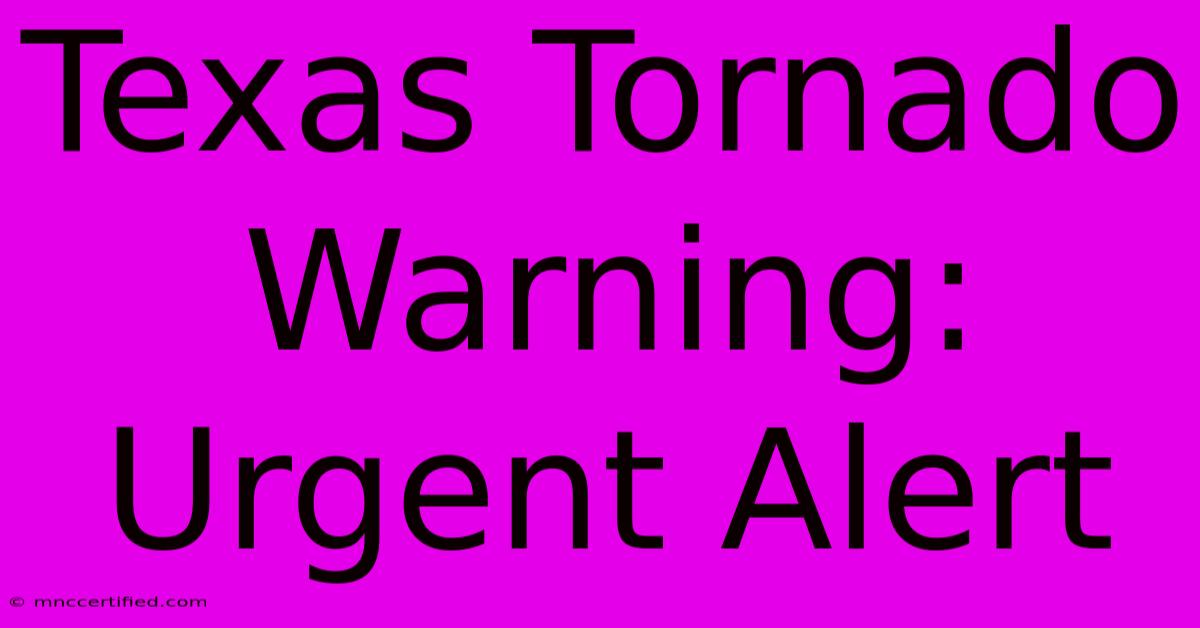Texas Tornado Warning: Urgent Alert

Table of Contents
Texas Tornado Warning: Urgent Alert
Texas is no stranger to severe weather, but when a tornado warning is issued, it demands immediate attention. This article provides crucial information on how to stay safe during a Texas tornado warning, understand the alert system, and prepare for future severe weather events.
Understanding the Tornado Warning System
A Texas tornado warning means a tornado has been sighted or indicated by weather radar. This isn't a drill; it's a life-threatening situation requiring immediate action. The National Weather Service (NWS) issues these warnings based on Doppler radar data, spotter reports, and other meteorological evidence. These warnings are disseminated through various channels:
- NOAA Weather Radio: This is the most reliable source. A dedicated weather radio is essential for any Texan.
- Wireless Emergency Alerts (WEA): Your smartphone will receive an alert if you're in a warned area. Ensure your phone's emergency alert system is enabled.
- Local News: Television and radio stations provide real-time updates and coverage.
- The National Weather Service Website: Check the NWS website for detailed radar imagery and forecasts.
Key Differences: Watch vs. Warning
It's crucial to understand the difference between a tornado watch and a tornado warning. A watch means conditions are favorable for tornadoes to develop. A warning, however, indicates a tornado has been sighted or is imminent. A warning requires immediate action.
What to Do During a Texas Tornado Warning
When a tornado warning is issued for your area, immediate action is paramount. Your safety is the top priority.
Seek Immediate Shelter:
- Go to a sturdy interior room on the lowest level: Basements are ideal. If a basement isn't available, choose an interior room, such as a closet or bathroom, away from windows.
- Get under a sturdy piece of furniture: A heavy table or desk can offer protection from flying debris. Cover yourself with a blanket or mattress if possible.
- Stay away from windows: Windows are the most vulnerable points during a tornado.
- If you are in a mobile home: Leave immediately and seek shelter in a sturdy building. Mobile homes are extremely vulnerable to tornado damage. This is your most critical action during a tornado warning.
- If you are outdoors: Seek shelter immediately in a low-lying area, such as a ditch or culvert, and cover your head.
Staying Informed:
Continue monitoring weather reports and updates from reliable sources throughout the duration of the warning and even after it expires, as conditions can remain hazardous.
Preparing for Future Tornado Seasons
Proactive preparation is key to mitigating the risks associated with Texas tornadoes. Taking steps before a warning is issued can significantly increase your safety and preparedness.
Creating a Family Tornado Plan:
- Identify a safe room: Determine the safest location in your home.
- Designate a meeting place: Choose a location outside your home where your family can reunite after the storm.
- Assemble an emergency kit: This should include water, non-perishable food, a first-aid kit, flashlights, batteries, a radio, and essential medications.
- Practice your plan: Regularly practice your tornado safety plan with your family so that everyone knows what to do in an emergency.
Strengthening Your Home:
While you cannot make your home completely tornado-proof, reinforcing certain aspects can improve its structural integrity:
- Install storm shutters or board up windows: This helps protect against flying debris.
- Reinforce your garage door: Garage doors are a weak point in many homes. Consider reinforcing it with extra bracing.
- Anchor heavy objects: Secure any heavy objects that could become airborne during a tornado.
Texas tornado warnings are serious events that demand immediate action. By understanding the warning system, knowing how to react, and preparing in advance, you can significantly improve your chances of surviving a tornado and minimizing damage to your property. Remember, safety is paramount. Stay informed, stay vigilant, and stay safe.

Thank you for visiting our website wich cover about Texas Tornado Warning: Urgent Alert. We hope the information provided has been useful to you. Feel free to contact us if you have any questions or need further assistance. See you next time and dont miss to bookmark.
Featured Posts
-
Carrot Recall E Coli Outbreak
Nov 19, 2024
-
Seven Match Ban For Spurs Midfielder Bentancur
Nov 19, 2024
-
Spirit Airlines Files For Chapter 11
Nov 19, 2024
-
Non Owners Insurance Charlotte Nc
Nov 19, 2024
-
30 Day Short Term Truck Insurance
Nov 19, 2024